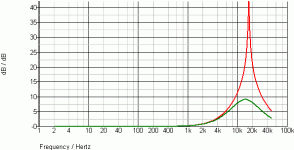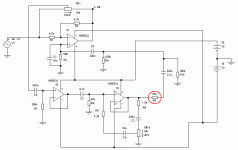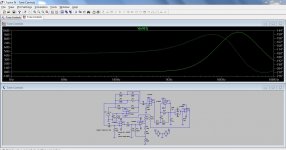Very well thought-out post paranoid. Thanks. I guess your points about air as the medium does have some validity. It's perhaps why many audiophiles have a separate listening room, or one that's even designed intentionally for listening. The lucky ones are able to build such a room and include factors like double-drywall, isolation characteristics, green glue, wall treatments, bass-traps and the like to quiet the room, or remove standing waves. Even as we speak I'm doing the same thing as I build-out my basement office, media room. So your points are well taken.
As to op-amp rolling... many DIY'ers who build amps, DACs and other gear like to experiment with different op-amps to see if they can hear a difference. I'm not so convinced, but I will say I have tried it and have never found the audio differences to be significant. Perhaps I was in the wrong mood! I generally like to start with solid specs - which is why I like Doug Self's approach to his designs and why I decided to build his new preamp last year. I've been very happy with its performance in my various system(s).
I generally like to start with solid specs - which is why I like Doug Self's approach to his designs and why I decided to build his new preamp last year. I've been very happy with its performance in my various system(s).
Thanks again for sharing your thoughts and enjoy this hobby!
As to op-amp rolling... many DIY'ers who build amps, DACs and other gear like to experiment with different op-amps to see if they can hear a difference. I'm not so convinced, but I will say I have tried it and have never found the audio differences to be significant. Perhaps I was in the wrong mood!
Thanks again for sharing your thoughts and enjoy this hobby!
Thanks redjr for your nice words
And as for removing standing waves - if only your room has at least 2 parallel walls, and I'm sure 99% of the rooms do have them (unless you install some kind of curtains or something similar) then you can't avoid standing waves, it's just physics. AFAIK, in a typical cuboid room you always have some mods. And the trick is to, by a clever choice of proportions between height, width and length, to introduce as many mods as possible, so that no frequency in any standing point in the room can be severely stronger or weaker than other. The frequency response of such room is not flat, it has lots of 'bumps' but since there are so many of them, located close to each other, the whole response seems pretty flat.
But, as I said, IMO it has nothing to do with the air as a non-perfect medium.
Of course it doesn't mean that the overall response of the room doesn't have an audible effect on what we hear, even if we are really close to the speakers. In fact, it has a huge impact, which leads to the conclusion, that some op-amps characteristics, like dullness, crispness or whatever can be heard by some and completely unheard by others, since the acoustics of the room may lessen or emphasize some impressions. Gee, I wish I could express that better in English.
BTW, many diyers here share their impressions re different op-amps, yet, due to the very nature of the forum, they do not meet in person to correlate it with each other and to agree on the language they use to describe various sound characteristics. Which is what makes the whole comparison much less convincing, IMHO.
And, apart from using different words for describing the same impressions, they obviously have these op-amps operating in different layouts (even if in the same designs). And the layouts always differ in grounding scheme, decoupling techniques, impedances of ground planes (hence in IR drops along the plane), return current paths, levels of crosstalk and so on. Imagine a situation where one op-amp, with a CMRR of say 70dB @ 1kHz is replaced with the one that has 50dB and a person claims that the new one produces a strangled sound, not so natural as the original op-amp. But it may be due to the same level of common mode noise on the lines resulting in a 20dB higher level of crosstalk between channels. It's just an example and I'm sure we can think of many other scenarios like this.
I agree with everything, however that's not what I meant. I was referring to the air itself, not to the acoustics of the room one listens to music in. You mentioned wall treatments or bass-traps - they do affect the response of the room, level of reverberation, overall amplitude response and so on, but it has nothing to do with the air as a medium of wave propagation.I guess your points about air as the medium does have some validity. It's perhaps why many audiophiles have a separate listening room, or one that's even designed intentionally for listening. The lucky ones are able to build such a room and include factors like double-drywall, isolation characteristics, green glue, wall treatments, bass-traps and the like to quiet the room, or remove standing waves.
And as for removing standing waves - if only your room has at least 2 parallel walls, and I'm sure 99% of the rooms do have them (unless you install some kind of curtains or something similar) then you can't avoid standing waves, it's just physics. AFAIK, in a typical cuboid room you always have some mods. And the trick is to, by a clever choice of proportions between height, width and length, to introduce as many mods as possible, so that no frequency in any standing point in the room can be severely stronger or weaker than other. The frequency response of such room is not flat, it has lots of 'bumps' but since there are so many of them, located close to each other, the whole response seems pretty flat.
But, as I said, IMO it has nothing to do with the air as a non-perfect medium.
Of course it doesn't mean that the overall response of the room doesn't have an audible effect on what we hear, even if we are really close to the speakers. In fact, it has a huge impact, which leads to the conclusion, that some op-amps characteristics, like dullness, crispness or whatever can be heard by some and completely unheard by others, since the acoustics of the room may lessen or emphasize some impressions. Gee, I wish I could express that better in English.
I can see that Douglas Self is a really respected engineer among all diyers and I'm sure I'll buy one of his books someday. However I've also seen many people complaining about his strong objectivist approach. But I guess I want to build one of his designs anyway, just to see for myself, whether 'as low THD+N as possible' is all there is to it, or should I rather follow the ones claiming that SQ can be sometimes not-so-correlated to what the measurements say. I hope someday I'll be able to tell that myself without resorting to other people's opinions.which is why I like Doug Self's approach to his designs and why I decided to build his new preamp last year. I've been very happy with its performance in my various system(s).
BTW, many diyers here share their impressions re different op-amps, yet, due to the very nature of the forum, they do not meet in person to correlate it with each other and to agree on the language they use to describe various sound characteristics. Which is what makes the whole comparison much less convincing, IMHO.
And, apart from using different words for describing the same impressions, they obviously have these op-amps operating in different layouts (even if in the same designs). And the layouts always differ in grounding scheme, decoupling techniques, impedances of ground planes (hence in IR drops along the plane), return current paths, levels of crosstalk and so on. Imagine a situation where one op-amp, with a CMRR of say 70dB @ 1kHz is replaced with the one that has 50dB and a person claims that the new one produces a strangled sound, not so natural as the original op-amp. But it may be due to the same level of common mode noise on the lines resulting in a 20dB higher level of crosstalk between channels. It's just an example and I'm sure we can think of many other scenarios like this.
D.Self may be an objectivist style designer, but that does not detract from his electronics knowledge.
His books give excellent guidance with worked examples that are guaranteed to perform as he describes.
More importantly he shows the reader/learner "how to".
That "how to" can then be applied in a knowledgeable fashion to any equipment, whether it is being designed in the objectivist, or subjectivist style.
The difference is that the objectivist trained builder will recognise what should be checked to ensure the subjectivist "contraption" is actually capable of performing !
I have read about many subjectivist designs that cannot perform and worse the designer probably did not know that "his contraption" had been crippled to such an extent that it was impossible for it to reach a "High Fidelity" performance !!!!
His books give excellent guidance with worked examples that are guaranteed to perform as he describes.
More importantly he shows the reader/learner "how to".
That "how to" can then be applied in a knowledgeable fashion to any equipment, whether it is being designed in the objectivist, or subjectivist style.
The difference is that the objectivist trained builder will recognise what should be checked to ensure the subjectivist "contraption" is actually capable of performing !
I have read about many subjectivist designs that cannot perform and worse the designer probably did not know that "his contraption" had been crippled to such an extent that it was impossible for it to reach a "High Fidelity" performance !!!!
You're completely right, I don't neglect his thorough knowledge on the matter. I've seen his website and I've read some of his comments. I just hope someday I'll be able to judge by myself whether his approach is unquestionably right or not.D.Self may be an objectivist style designer, but that does not detract from his electronics knowledge.
And that's what I'm about to with the equipment I will build. I know his books are widely considered a must-read.That "how to" can then be applied in a knowledgeable fashion to any equipment, whether it is being designed in the objectivist, or subjectivist style.
There is a rather nice build of this preamp over yonder,
http://www.diyaudio.com/forums/analog-line-level/252854-douglas-self-preamp-2012-a.html#post3854972
http://www.diyaudio.com/forums/analog-line-level/252854-douglas-self-preamp-2012-a.html#post3854972
Hey Mooly, thanks for the link. I missed this one and was glad to see someone else tackle the preamp project. Unfortunately, my preamp is still boxed up from a move last year. I'm in the middle of building out my man-cave/listening/media room and office space. As usual I'm putting in a lot of sweat-equity to save on cost, so it's taking longer. After 10 hours at the office everyday, can't say I wait to get home and head to the basement!There is a rather nice build of this preamp over yonder,
http://www.diyaudio.com/forums/analog-line-level/252854-douglas-self-preamp-2012-a.html#post3854972
Rick
Has anybody simulated the Mr. Self's precision preamp linked by Mooly?No, but the 96 precision preamp is viewable on Google Books, chapter 11.
Small- Signal Audio Design - Douglas Self - Google Books
I need to build a preamp and Mr. Self's tone control with variable frequency seems almost ideal for my needs, so I've trying to test it by using Simetrix and I've found an error
I guess I can upload the schematic used in the simulation, as it is just the HF tone control section and its frequency response:
As can be seen in the pictures, when VR1 is set to maximun boost (or maximun cut... its the same thing) the frequency response gives a huge peak (the red curve) at the frequency selected by VR3. However, the behaviour of the tone control is as specified if VR1 wiper only moves between 20% and 80% of its full span.
The problem is related to the value of R8, which is set to 470R in the Small Signal Audio Design book, and that value doesn't build a 9 dB loss as Mr. Self specify. Just changing R8 to 1K we can get the green curve at a maximun boost of almost 10dB as it should be (and the loss will be -8.8dB)
Has anybody verified this error by using another simulator or a spectrum analyzer or something like that?
Attachments
Hi,
I simulated this design (precision pre-amp '96 from Self on Audio book) a long time ago, using Orcad pspice. I had both the bass and treble sections going. I do not recall that I saw the peaking that you are experiencing.
I have not simulated the design in ltspice(which is what i use mostly now due to popularity) nor your spice tool nor have i built/tested the ckt. I did do a layout but did not fab it. But it seems to be a really nice design and as close as you will get to a parametric(SVF) type design with a lot less op-amps.
Thx
Rick
I simulated this design (precision pre-amp '96 from Self on Audio book) a long time ago, using Orcad pspice. I had both the bass and treble sections going. I do not recall that I saw the peaking that you are experiencing.
I have not simulated the design in ltspice(which is what i use mostly now due to popularity) nor your spice tool nor have i built/tested the ckt. I did do a layout but did not fab it. But it seems to be a really nice design and as close as you will get to a parametric(SVF) type design with a lot less op-amps.
Yes please!!Do you want the LTspice file ?
Thx
Rick
Last edited:
Thx Mooly,
That's great, I tried the original ckt that you posted, using both treble boost/cut at max and it works fine, same as when I did it in pspice.
So must be something wrong with originators circuit or simulator. Don't have the S/W so I have no means to find a solution, have not thoroughly gone over the schematic however, but if he compares against your sch. then maybe he will be able to find the fault.
BTW, I have been playing/simulating the Sansui diamond differential symetrical design, as was used in AU-X1, BA-F1,AU-919 models. I have the 20K THD into 4 ohm load down to 0.001% which i find to be pretty darn good. If you are interested I'll post it in anew thread.
Cheers
Rick
That's great, I tried the original ckt that you posted, using both treble boost/cut at max and it works fine, same as when I did it in pspice.
So must be something wrong with originators circuit or simulator. Don't have the S/W so I have no means to find a solution, have not thoroughly gone over the schematic however, but if he compares against your sch. then maybe he will be able to find the fault.
BTW, I have been playing/simulating the Sansui diamond differential symetrical design, as was used in AU-X1, BA-F1,AU-919 models. I have the 20K THD into 4 ohm load down to 0.001% which i find to be pretty darn good. If you are interested I'll post it in anew thread.
Cheers
Rick
Oh... yes please! It would be very nice!Do you want the LTspice file ?
Edit---------------------------------------
Ooppsss! I´m a bit late.
Thank you Mooly!!!! It will be very useful because Simetrix (demo edition) complains due too many nodes for the simulation.
Thanks again!!!

Last edited:
Okay,
I started a new thread. I can use all the pointers in ltspice or design in general that i can get
http://www.diyaudio.com/forums/soli...pa-simulation-possible-build.html#post3878361
I started a new thread. I can use all the pointers in ltspice or design in general that i can get
http://www.diyaudio.com/forums/soli...pa-simulation-possible-build.html#post3878361
- Home
- Source & Line
- Analog Line Level
- New Doug Self pre-amp design...


